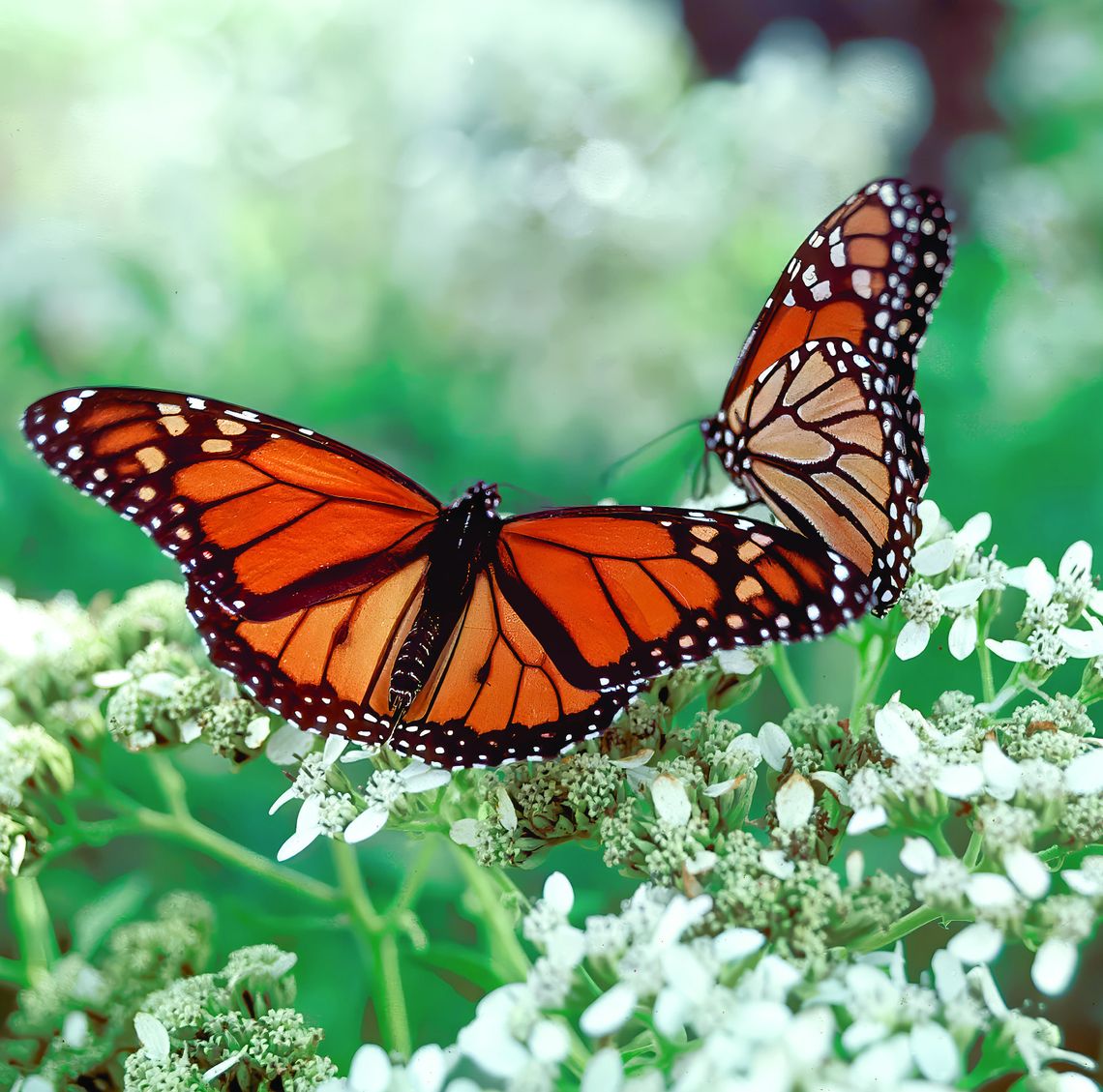I am a member of the Highland Lakes Master Naturalists, Highland Lakes Birding and Wildflower Society, and Native Plant Society of Texas. But of all my natural endeavors, butterflies are my passion. The more I learned, the more I enjoyed it. I was frequently thinking, “What is that butterfly? What is that “worm”? Is that a butterfly or a moth?” Since retirement, I have strived to answer more of those questions.
Perhaps you, like me, have wondered these same things. Here’s a little information about these beautiful insects to get you started in learning. Butterflies and moths are 4-winged insects in the order Lepidoptera. The wings of butterflies usually fold together when at rest. Moths’ wings are usually open when at rest and most are less colorful than butterflies.
Butterflies are usually more active in the daytime and moths at night, and all go through complete metamorphosis (egg, larva [caterpillar], pupa, adult). Some species lay their eggs on only one species of plant called a host plant which the larvae will feed on, while others may have several species of host plants that they lay their eggs on. On the other hand, all adults drink nectar from several plant species but may have favorites. The larva (caterpillar) is not a worm. You can tell the difference because worms don’t have legs, but larvae do.
The majority of butterflies and moths live only a few weeks in the adult stage but may go into a dormant phase when it gets too cold, overwintering in the larval stage, with pupae being the next most common choice, followed by eggs and adults. However, some migrate to a warmer climate.
Here are a few of the common butterflies and moths found in the Austin County area to look for.
.JPG)
.JPG)
.jpg)
.JPG)
The Monarch (Danaus plexippus) is probably the most well-known butterfly in North America. It is the only known butterfly to migrate to one particular area in the winter. Monarchs that live east of the Rocky Mountains migrate to an area in the mountains of central Mexico. Those who live west of the Rockies migrate to places along the coast of California. They can be seen in our area only as they migrate through – September-November as they go south and March-June as they go north. Most egg-laying takes place on the journey back north. These eggs are laid only on milkweed plants; therefore, the larva eats only milkweed. Monarchs are in great decline. While listed on the Red List of endangered species by the International Union for the Conservation of Nature, it is not listed as endangered under the Endangered Species Act by the U. S. Fish and Wildlife Service but is instead on the candidate list to be reviewed annually.
.JPG)
.JPG)
The Queen butterfly (Danaus gilippus) looks a lot like a Monarch, but it is slightly smaller, has thinner wing veins, and has more white spots on its hind wing edge. Queens are in our area from May until November, surviving the cold months in their chrysalises (pupa stage). The host plant for Queens is also only milkweed. Their larva is similar to the Monarch’s but can easily be distinguished from the Monarchs by the extra tentacle in the middle of its back. One of their favorite nectar plants is a mistflower.
.JPG)
.JPG)
.JPG)
The Gulf Fritillary (Agraulis vanillae) is another of our orange butterflies. The underside of the wings is brown and speckled with silvery white dots. In contrast, the top surface layer of the wings is deep orange with black streaks running across. This butterfly also has only one species of host plant and that is the passion vine. Gulf Fritillaries have a chemical defense mechanism in which they release odorous chemicals in response to predator sightings. As a result, common predators learn to avoid this species.
.jpg)
.JPG)
Red Admiral (Vanessa atalanta) This medium-sized butterfly with black wings, red bands, and white spots has a wingspan of about 2 inches. It overwinters in warmer areas of Texas and migrates north in spring and sometimes again in autumn. It has been my experience that if I see a butterfly on a sunny winter day, it is usually a Red Admiral. Its host plants are in the Nettle family – primarily stinging nettle. The adult butterfly not only feeds on nectar but also sap, rotting fruit, and moisture from mud puddles. The larvae are yellow-green to black with spots and short spines. It conceals itself by making a tube of leaves in which it lives while also eating its shelter.
.JPG)
.JPG)
Sulphur (Pieridae family; subfamily Coliadinae) Sulphur butterflies are a large group of bright yellow or orange butterflies. While they vary in patterns on the top (dorsal) side of their wings, many of their undersides (ventral) which we see most often, are very similar. This ventral side has a few small irregular spots scattered all over and a larger single or double spot in the center of the hind wing. Many host plants are in the legume family including partridge peas, sennas, and clovers and among their favorite nectar plants are lantana, zinnia, and Turk’s Cap. Some are here year-round, others migrate. The larvae vary from light green to yellow with black rings and small spots. Among the sulphurs in our area are Cloudless, Orange, and Little Sulphurs.
.JPG)
.jpg)
Black Swallowtail (Papilio polyxenes) There are several types of swallowtails in our area. All have a forked appearance on their tail mostly visible when they rest spreading out their wings. The Black Swallowtail has two rows of yellow spots along the edge of its forewings. On its hind wings is one row of yellow and an outer row of blue spots with a single red dot where the hind wings come together. Its host plants are in the carrot family such as dill, parsley, and Queen Anne’s Lace. The larvae are pale green with black bands. The wider bands have yellow spots on them.
Black swallowtail caterpillars possess a unique defense mechanism called the osmeterium. The osmeterium is an orange, forked, horn-like organ located behind the caterpillar’s head. When threatened, the caterpillar can turn this organ outward and emit an unpleasant odor to deter predators.
.jpg)
.JPG)
Salt Marsh Moth (Estigmene acrea) This past spring, 2024, you probably saw a large number of black, fuzzy caterpillars crawling around. They were hard to miss as they crawled across streets, up the sides of houses, and on plants. These were Salt Marsh caterpillars. This species found perfect climate conditions at that time which resulted in a significant population increase. These Salt Marsh larvae have many color variations from black with orangish-red markings to pale yellow to reddish-brown. The ones I saw last spring were black. They are not poisonous, nor do they sting, but some people may be sensitive to the hairs (setae). They have a wide range of hosts, feeding on numerous broadleaf plants including trees, shrubs, crops, and others.
The Salt Marsh larvae become Salt Marsh moths. These adult moths are medium-sized and have white forewings with black dots. Hind wings are white in females and peachy yellow in males. The adult’s head and thorax are white, and the abdomen is peachy yellow with black oblong spots.
Other than their intrinsic and aesthetic value, both butterflies and moths provide a wide range of environmental benefits including pollination and natural pest control. They are second only to bees as pollinators. They are an important part of the food chain in all their stages and are prey for many including birds, bats, lizards, and other insects.
Butterflies face a wide range of threats including habitat loss, climate change, disease, pesticides, and invasive plants. In the United States alone, five butterflies have gone extinct since 1950; an additional twenty-nine butterflies are listed as endangered nationwide, and six are listed as threatened. Of the approximately 800 butterfly species in the United States, 19 percent are currently at risk of extinction. Most of the butterflies at risk of extinction are rare endemics—those species that have a narrow geographic range or very specific habitat requirements. However, the broadly distributed butterflies such as the ones discussed above are also in decline.
I hope you will take time to enjoy these “jewels in the sky!”
Resources: Field guides – Kaufman Field Guide to Butterflies of North America; Peterson First Guide to Butterflies and Moths of North America; Peterson Field Guide to Moths; a quick guide folder “Butterflies of Central Texas” by Valerie G. Bugh; Online guides: IDnature guide at www.discoverlife.org/nh/id/lucid and www.inaturalist.org
ABOUT THE WRITER
Sondra Fox is a Central Texas resident, and a member of the Highland Lakes Master Naturalists, Highland Lakes Birding and Wildflower Society, and Native Plant Society of Texas.




Comment
Comments